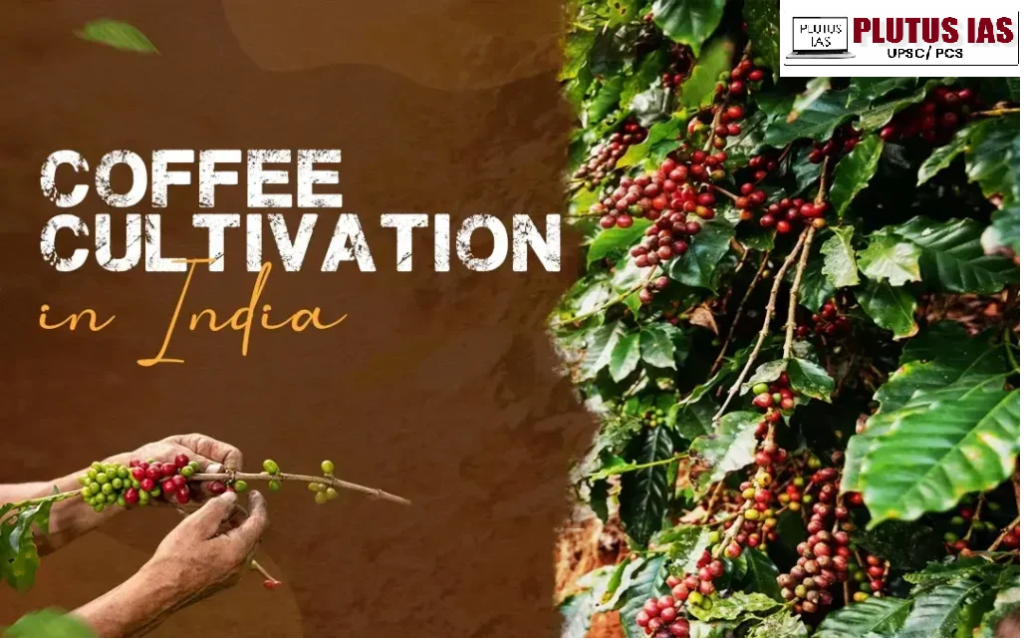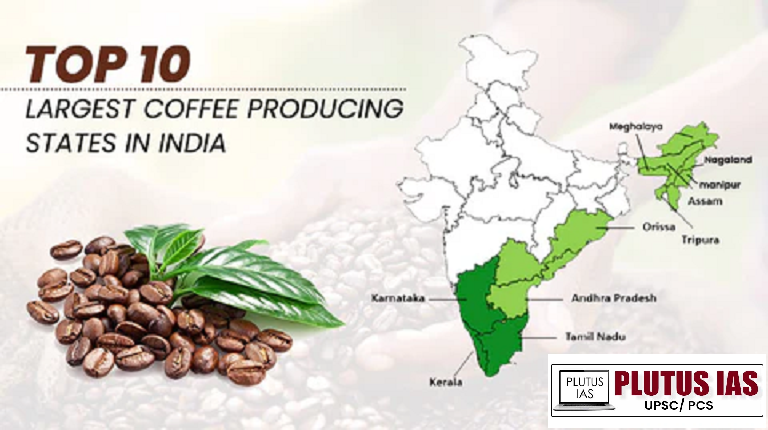23 Jan Indian Coffee Brews Global Demand
SYLLABUS MAPPING:
GS-3- Environment- Indian Coffee Brews Global Demand
FOR PRELIMS:
Basic climatic conditions for cultivations of coffee crop, Key Facts Tea Board of India.
FOR MAINS
Why is there a high demand for Indian coffee in the international market? Coffee sector challenges and ways to address these challenges
Why in the news?

Coffee in India:
Coffee Productions:
Climate and Environmental Conditions for Coffee Growth
| Factor | Description |
|---|---|
| Temperature | Ideal range: 73–82 °F (23–28 °C). No variety tolerates temperatures near 32 °F (0 °C). High temperatures during flowering can reduce bean size. |
| Rainfall | Requires 60–80 inches (1,500–2,000 mm) annually. Low rainfall and cool temps during the growing season can result in small beans. High rainfall and low temps during harvest can lead to bean defects. |
| Humidity | High humidity promotes diseases and pests. |
| Sunlight | Requires some shade, especially in hotter climates. |
| Altitude | Arabica grows best at elevations of 2,000–6,500 ft (600–2,000 m). |
| Soil | Physical and chemical soil characteristics are critical for healthy growth. |
| Wind | Wind can negatively affect coffee plants. |
| Topography | The landscape and landform impact coffee plant growth. |
| Climate Change | Rising temperatures and unpredictable rainfall patterns can reduce yields, create smaller beans, and increase vulnerability to pests. |
Coffee Board of India (CBoI):
| Aspect | Description |
|---|---|
| Establishment | Constituted under Section 4 of the Coffee Act, 1942. |
| Composition | The Board comprises 33 Members, including the Chairperson. |
| Headquarters | Located in Bengaluru, Karnataka, India. |
| Powers | Authority to regulate and promote coffee production and export. The ability to provide financial assistance to growers. Power to conduct research and implement welfare measures for labourers. |
| Functions | Research & Development: Focus on improving coffee quality and productivity. Promotion: Promote coffee within India and abroad. Extension: Provide training and skill development to coffee growers. Welfare Measures: Ensure better working conditions for labourers in coffee plantations. Market Intelligence: Gather data to assist in marketing and export strategies. Export Promotion: Enhance India’s coffee exports globally. |
Factors for the high demand for Indian coffee:
1. Quality: Indian coffee, especially Arabica, is valued for its mild, aromatic flavour. In 2020, India produced about 5.4 million 60-kg bags, with Arabica being a key contributor.
2. Unique Flavors: India produces varieties like Arabica, Robusta, and Monsooned Malabar. The Monsooned Malabar, processed by a unique method, is particularly popular in Europe.
3. Sustainable Practices: Over 20% of India’s coffee is organic, aligning with global demand for eco-friendly products.
4. Global Recognition: India is the 8th largest coffee exporter, with over 4.1 million 60-kg bags exported in 2020, mainly to the US, Italy, and Germany.
5. Growing Coffee Culture: India’s coffee market grows by 15-20% annually, driven by expanding café culture, especially in cities like Bengaluru and Mumbai.
6. Competitive Pricing: Indian Robusta is 30-40% cheaper than other global sources, making it attractive to international buyers.
7. Export Strength: India exports 70% Robusta and 30% Arabica, with major markets in the US, Russia, and Italy.
8. Ideal Climate: Coffee is grown in regions like Karnataka and Kerala, where conditions (altitude of 600-1,200 meters) are perfect for both Arabica and Robusta.

Issues grappled with coffee production in India:
1. Climate Change and Unpredictable Weather: Erratic rainfall, rising temperatures, and extreme weather events like droughts and floods disrupt coffee flowering and fruit maturation, leading to reduced yield and quality.
2. Pests and Diseases: Coffee is susceptible to pests (e.g., coffee berry borer) and diseases (e.g., coffee leaf rust), affecting crop health and reducing quality. Effective pest management is costly and challenging, particularly for small farmers.
3. Labor Shortage and High Costs: Coffee farming requires manual labour for tasks like harvesting, but there is a shortage of skilled labour, and labour costs are rising. This can lead to delays in harvesting and affect bean quality.
4. Inadequate Infrastructure: Poor transportation and storage facilities in coffee-growing regions delay the movement of harvested coffee, affecting quality. Lack of proper storage also leads to quality degradation post-harvest.
5. Water Scarcity and Irrigation Issues: Coffee needs consistent water, and in areas with unreliable irrigation, water stress during critical growth stages affects yield and quality.
6. High Input Costs and Low Profits: The cost of seeds, fertilizers, and labour is high, while global price volatility leads to uncertain income, squeezing profit margins for farmers.
7. Limited Access to Modern Technology: Adoption of modern farming practices and machinery is limited, leading to inefficiencies and lower productivity, especially for small-scale farmers.
8. Aging Plantations: Older coffee plantations lead to declining yields and quality. Replanting new trees is costly and requires long-term investment.
9. Post-Harvest Losses: Improper drying, storage, and processing of beans result in quality loss and reduced market value.
10. Market and Price Instability: Fluctuating global coffee prices make it difficult for farmers to predict their income, often resulting in financial instability.
Way forward:
1. Awareness: Educating farmers through training and workshops equips them with skills in pest control, disease management, and harvesting techniques, enabling informed decision-making and sustainable practices.
2. Research: Investing in research helps identify innovative solutions, such as disease-resistant varieties and improved farming techniques, addressing key farming challenges.
3. Financial Support: Access to credit and resources enables farmers to invest in equipment, inputs, and technology, enhancing productivity and helping to tackle challenges effectively.
4. Government Support: Government policies, subsidies, and research funding play a crucial role in supporting farmers and promoting sustainable coffee farming practices.
Download Plutus IAS Current Affairs (Eng) 23th Jan 2025
Conclusion:
India’s coffee industry is growing, with record exports driven by global demand for unique varieties. Challenges like climate change, pests, labour shortages, and infrastructure issues affect productivity and quality. To address these, India needs to focus on educating farmers, investing in research, providing financial support, and implementing government policies. These efforts will help farmers adapt to challenges, boost productivity, and sustain growth, reinforcing India’s position as a top coffee exporter and growing domestic market.
Prelims Question:
Q. Consider the following statements:
1. India is the largest producer of coffee in the world.
2. The Coffee Board of India was established in 1942 under the Coffee Act.
3. Coffee is predominantly grown in the southern states of India, especially Karnataka, Kerala, and Tamil Nadu.
How many of the statements given above are correct?
A. Only one
B. Only two
C. All three
D. None
Answer: B
Mains Question:
(250 words, 15 marks)




No Comments